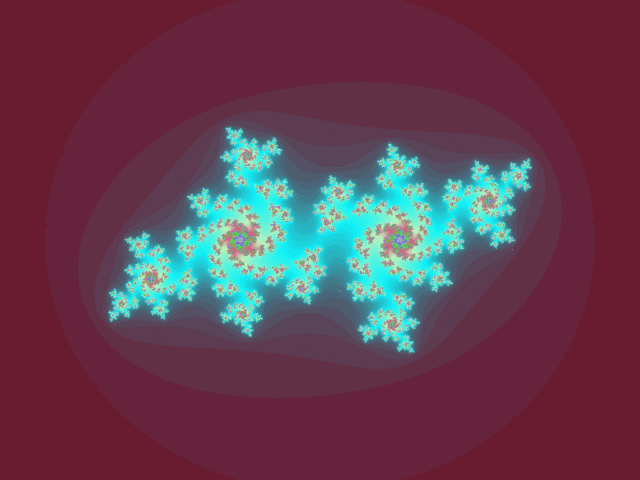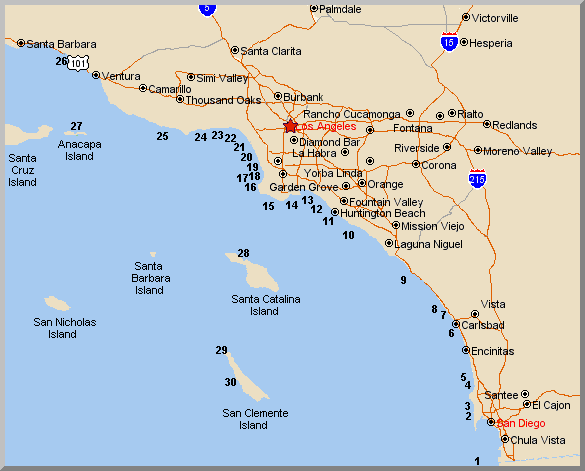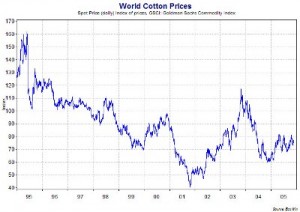This article originally appeared in the great astrological magazine, The Mountain Astrologer in the 90’s.
Astrology and Chaos Theory: Fractal Progressions by Anne Beversdorf

With an MC in Sagittarius, an Aquarius ascendant, and a Leo sun, I consistently find myself proselytizing avant-garde or unusual concepts. So, of course, as an astrologer, I’m often in the awkward position of trying to get my skeptical friends to see why astrology is a valid and meaningful discipline. Skeptics say they don’t “believe in” astrology, meaning that they do believe it doesn’t work. It’s tempting to say “If you don’t believe in gravity, does that mean gravity doesn’t work?”, but everyone can SEE the effects of gravity, and one can’t see the relationship of astrology to human life without knowing something about astrology. The challenge is, how can you show an astrological virgin something about astrology in their own life without bombarding them with the meanings of signs, planets, and houses, and how all that symbolism relates to life on earth? And how can you give them a rationale for how this works that compares to something they can accept? I’m beginning to realize that the new sciences, combined with some ordinary common sense, can help us take a giant step in this direction.
Some time ago I read James Gleick’s book, Chaos: Making a New Science. It’s a powerful and mind-expanding book, and I strongly recommend it to astrologers looking for possible scientific underpinnings for our field. [Note: Bernadette Brady’s recent book Astrology, A Place in Chaos, is really the last word on the subject.] Gleick’s book has been germinating in my subconscious mind for a few years, and recently something sprouted. Gleick speaks a lot about fractals–a new type of math that has been popularized by the “Mandelbrot Set” a collection of highly colored, computer-generated graphics that resemble nothing so much as a psychedelic paisley. The curious thing about these pictures is that, if you take any subsection of a picture and blow it up enough, you get the original picture again. And if you take a subset of that picture and blow it up enough, guess what–you get the original picture again–and so on and so on, ad infinitum. What makes this significant is that this mathematical picture-building seems to apply to the geometry of nature itself. Mandelbrot has named this geometry “fractals”.
Let’s examine this for a minute. Consider trying to measure the coastline of California. It proves impossible unless you identify the SCALE of your measurements.

To determine the measurements of California‘s coast, we could lay a single straight line running from Mexico to Canada: but that doesn’t take into account any of the coastline’s irregularities–all those bumps and bays and peninsulas. You could place an imaginary grid over the coastline and plot and measure distances between places where the coastline hit grid points–but how large or small will be your grid? It reminds me of my little sister’s statement after we walked home from her first day at school. “You say it’s a mile, but it would be a lot longer if you straightened out all the hills!” She was right! And if you measured the California coast by taking your measuring tape, millimeter by millimeter, around all the rocks and pebbles and outcroppings of the coastline, you’d have a distance that would astound us all, and apparently, be not at all related to one generally accepted figure of 1264 miles.
But–is there really no relationship? In fractal dimensions, there is, indeed a relationship. Rather than look at the Euclidean measurements of length, depth, and thickness, Mandelbrot asked the question in terms of “dimension”. To quote James Gleick:
A twisting coastline, for example, despite its immeasurableness in terms of length, nevertheless has a certain characteristic degree of roughness. Mandelbrot specified ways of calculating the fractional dimension of real objects,… and he allowed his geometry to make a claim about the irregular patterns he had studied in nature. The claim was that the degree of irregularity remains constant over different scales. Surprisingly often, the claim turns out to be true. Over and over again, the world displays a regular irregularity. (Italics added.)
Let’s apply this to the coastline: what happens is that any sub-portion of the coastline actually corresponds in shape to the pattern of the entire coastline. And a sub-portion of that sub-portion, again, corresponds to the same shape. Realize, we’re talking about patterns here–we’re seeing a mathematics of patterns. (In fact, the science of Chaos is the science of patterns in seemingly random events… does this begin to get interesting?)
Let’s look at something else. The financial astrologer, Arch Crawford, points out that the history of cotton prices is the longest complete data of market records available to U.S. market observers. Funny thing about cotton prices…. If you graph the history of cotton prices for all the years over the 140+ years of record-keeping and then graph the prices for any period of time–one year, one decade, one week–during that period, the graphs will display the same pattern! So what we are seeing here, again, is regularly repeating patterns.

Okay… how does this relate to astrology: Well, one technique commonly used in astrology is the examination of progressions to look into the timing of a person’s life. A Secondary Progression is a comparison of the pattern of the sub-portion “one day” to the pattern of the sub-portion “one year”. One type of Tertiary Progression compares one lunar cycle to one year. One of the things that blew me away when I first started studying astrology was my teacher’s statement that you could take any recognizable cycle of time in one’s life and make it “equivalent” to one year, therefore using it to “predict” patterns of that person’s future. Try that one on an incredulous friend! But astrologers know that this use of patterns is meaningful. In fact, we can take this quite literally, as you will see in a minute. I’m calling these arbitrarily assigned progression periods “Fractal Progressions”.
Astrology is a language of symbols: a language of meaning. Astrologers apply symbolic meanings to each of the planets used in casting a chart and take a measure of the patterns between these planets to interpret, symbolically, and sometimes specifically, the type of event likely to occur when this pattern is in place. This is one place where skeptics get tangled up. Since they don’t understand the symbolic language, they can’t understand that “patterns in the sky” have any relationship to their life on earth. They don’t cause events on earth any more than having brown hair causes brown eyes. They simply have a predictable relationship to each other. But in order to give someone an explanation of symbolism, you must use symbols that your listener understands and relates to.
Let’s look at progressions again. Another astrologer once suggested that parents of new babies keep a detailed diary of the first 90 days of the child’s life. This would provide a real-life background for interpreting secondary progressions as the child grows up. This really clicked for me. Although I didn’t have a detailed baby book, I did have anecdotal references for several significant events in my first 45 days. My mother tells the story that, after my birth, she stayed in Houston with her parents for several weeks after my dad moved to Indiana to begin his professorship. Therefore, sometime on my 43rd day of life, I boarded a train with my mother to move from Houston to Indiana, changing trains in New Orleans. Late in the 43rd year of my life, I quit a successful and lucrative career. Still unemployed after many months, I was conscious only that I was entering a very different phase of my life–what that would be, I couldn’t tell. Looking at this symbolically, it seemed, in my 43-44th year, that I was “on the train” between what I knew and what, in hindsight, I know to be my first home. As an infant, of course, I literally didn’t know where I was going. Did this trip in my infancy cause me to quit my job or drift in unemployment? Of course not. But the events are clearly symbolically related.
A few months after receiving my last income, I decided to use some of my free time and frequent flyer miles to take my first trip to Europe. I asked my mother if she would pick up expenses if I got us two tickets to Spain. (As I write this, I realize our railway tickets in 1949 were also “free”–courtesy of my grandfather’s position with Southern Pacific Railroad.) My mother said an enthusiastic “yes” to the trip, so after checking calendars, I scheduled our flights. Some weeks later it occurred to me that we had not taken a trip alone together SINCE I was 43-44 days old. That the second such trip would occur in my 44th year seemed pretty amazing. Well, I should have remembered that another part of the story might also have a parallel. Apparently, as an infant, I caused my mother some pretty dramatic trouble on the train. After our trip to Spain, I was forced to make a wry apology after I jumped all over her for no reason at all: “Sorry, Mom. When we were on that train in 1949, I literally dumped on you. Here we were, on our next trip together, and I managed to dump on you again.”
In astrological language, my Secondary Progressed Chart for July 19, 1993 (last day of earnings) is equivalent to the chart for Sept 27, 1949, at 5:17 pm in New Orleans, where we changed trains and the trouble began. These charts are the same because a secondary progressed chart IS a chart for the exact number of days after birth as your age–in this case, 43+ years=43+ days. This chart shows Sun square Uranus, with Mars and Pluto conjoined and square Venus, and Moon square Saturn. My 43-44th year coincided with transiting Pluto at the apex of a T-square with my natal Sun and Ascendant, the Uranus/Neptune conjunction opposing my natal Mars, and transiting Saturn on my ascendant squaring transiting Pluto approaching my MC ( transiting my relocated MC). On July 19, Venus squared Mars and semi-squared the Moon. It’s easy to see the heavy, and similar, patterns at work in both instances. But I didn’t need to know the astrology to feel the impact of the comparison.
“Symbolically parallel event periods….” What a great way to talk about progressions to a non-astrologer. But not everyone has information about their first 90 days. So I decided to check out a pattern of weeks, and a pattern of months. I was 43 weeks old on June 12, 1950. At that time in my life, my parents traveled back to Houston by car every summer, as soon as the school term ended in the spring. I don’t know if June 12 was the day that trip started, but it would have been very close to that date. I don’t know what happened in my life in March 1953, when I was 43 months old. But I was intrigued enough with the possibilities in choosing a periodicity for progressions-via memories to start trying this method of “fractal progressions” with friends, as a way of demonstrating some of the principles on which astrology is based. Here are some of the results:
At a wedding reception, I asked a young woman in her early thirties what might have happened between 30-35 days in her life, 30-35 weeks, and 30-35 months. She couldn’t think of anything in particular (it’s probably not unrelated to the fact that her life was going along smoothly at the time of the reception–we tend to remember most vividly the dramatic events!). Then she asked “Why were the years 24-29 so traumatic for me? Those were horrible years. I didn’t know what I was doing, I was totally lost. It was just awful.” I asked her what was going on at 24-29 days, 24-29 weeks, or 24-29 months. As a realization dawned, her eyes lit up. She said “I think it was about the time I was two years old that my grandfather died. He was my primary caregiver and I still remember how awful it was.” She searched the room, found her mother, and asked her when grandfather died. It was during her 24th month of life. I asked her if the period in her 20’s bore any symbolic resemblance to that earlier period. Yes, she said. She kept feeling that something was terribly wrong, something was lost or missing, and she might find it anywhere, but whenever she thought she had, she hadn’t. As a toddler, after her grandfather’s death, she kept running into the arms of bald men, because she identified them with her grandfather, but none of them filled his place. As a result of this conversation, without even identifying her Sun sign, we could talk about the energies associated with Saturn, and different ways this energy can be expressed in life. She could see some of the meanings involved with her five-year sense of loss, and her search for a sense of structure and order in her twenties, as part of –and a more mature version of– the same symbolic package as the loss of her grandfather at two.
Another friend has few memories of her early life, so we tried using a different “periodicity”. We decided to look at her life in terms of 2-month periods representing a year. Events up to her first birthday would correspond to the first six years of her life. Using this scale she was able to relate events of her sixth year to her present life. At that time, she entered first-grade wearing clothes that caused the kids to tease her about looking “like a boy”. At this time, she is consciously trying to learn ways to express her femininity while still being successful in a career. When we looked at a 4-months equals a year period, she realized she was dealing with issues of femininity strongly again at age 12, when she entered the social world of junior high. A first-house Sun-Pluto conjunction in Leo and a Mars-Venus conjunction in her third, with Mars at 29′ 52″ Virgo and Venus at 00′ 00″ Libra indicates the significance of these issues in her life, and the development of this issue over her life reflect her personal growth, culminating at this time, with a more mature understanding of “femininity”.
As I thought about the relationship between fractals and progressions, I realized that if virtually ANY period could be used as a “fractal progression”, the easiest thing is to simply divide your current age in half–and for fine-tuning, into quarters. I’m 44 now. At 22 I again moved from Texas, where my husband and I had completed our undergraduate work, to my hometown in Indiana, where he would enter graduate school. It was another clear and parallel transition–to home. At 33, I got my first real “professional” job at a “professional” salary. At 11 my second sister was born–the baby I fell in love with and who changed my life. In my mid-40’s new beginnings and transitions were the theme for my life. I asked a friend at a party what happened in her life when she was half her age. Recently widowed, her husband died when she was 46. At 23 her mother died. Another friend, at 53, has been doing whatever “pickup” work she can find in a long period between “real” work. At 26 (half of 54) she was divorced. The period before the divorce was a long, grinding, depressed period. After the divorce, her life improved.
Fractal progressions not only provide non-astrologers with a personally understandable experience of what astrology is all about, it also provides outcomes. It provides a glimpse of “how things turned out”, and therefore “how things might turn out this time”. Astrologers can use this information to supplement interpretations of transits, standard progressions, and solar returns, in much the same way we already use information when we ask a client with a Sun/Saturn square “What happened to you 14 and 21 years ago?”
The point here is not to describe a “simple technique of predicting your future and understanding your past,” although it’s fun to look at the symbolic parallels. I see fractal progressions as a way to demonstrate to skeptical non-astrologers how astrological patterns work. You can briefly describe planetary archetypes involved with the significant memories of a person’s life and guide them into reaching their own understanding of meaning and planetary symbolism. They can clearly see that hating their teacher in first grade, for example, didn’t cause their marital conflicts at 48, but there may be an understandable symbolic relationship.
This approach allows one to step around one of the big misunderstandings about astrology: namely that old bugaboo about planets “causing” events. Just because two events occur at the same time–say, your progressed Saturn transiting your eighth house Moon may occur at the same time as the death of your mother– it doesn’t mean that one event causes the other. They are both part of the same repetitive pattern of occurrences–part of the same fractal pattern.
To a skeptic determined to deny all symbolic relationships, looking at fractal progressions in his or her own life certainly wouldn’t constitute “proof” of anything. On the other hand, we all know people who are genuinely open to different ways of viewing the world and who have no basis for personally understanding how the patterns reflected in the stars relate to their lives. This concept has been useful to me as a way of beginning to relate our field directly to aspects of the new scientific paradigms and explaining it to non-astrologer friends. I encourage readers of this article to experiment with fractal progressions in their own lives and those of friends.


